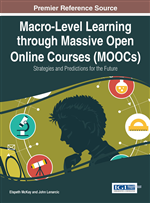MOOCs: Evolution and Revolution Gets Personal Part 2
In Part 1 of this post, I looked in general about the the idea that Massive Open Online Courses are both a revolution and an evolution.
The initial disruption of the MOOC was billed by many as a revolution and feared as such by many in academia. That peaked in 2012 (the “Year of the MOOC”) and was followed in 2013 with the sarcastic nickname of the “Year of the MOOC Hype”.
That is behind us and the evolutionary stage of MOOCs in the development of online learning is upon us. It may still have a revolutionary impact on learning and institutions.
 I'm focusing on the research for the chapter, "MOOCs: Evolution and Revolution," that my wife, Lynnette, and I did for the book, Macro-Level Learning through Massive Open Online Courses (MOOCs): Strategies and Predictions for the Future
I'm focusing on the research for the chapter, "MOOCs: Evolution and Revolution," that my wife, Lynnette, and I did for the book, Macro-Level Learning through Massive Open Online Courses (MOOCs): Strategies and Predictions for the Future
Our own online history has been an evolution from traditional classroom teaching, infusing distance and online learning, to designing and teaching in a MOOC setting and that is the focus of this particular post.
In 1994, when France was using the Minitel (Médium interactif par numérisation d'information téléphonique) primarily as an online phone book, shopping catalog and train schedule, the Minitel terminals were available free in France as well as in its territories and countries where French was a primary language. Lynnette received a small grant to take advantage of the opportunity that the French Embassy in New York made of software available free to Americans with a minute-by-minute charge for phone via a modem. Her American AP French high school students in New Jersey connected with Moroccan students preparing for the baccalaureate exam (BAC).
My first foray into using online for education was when I was also teaching in a secondary school (English) and encountered ThinkQuest. Lynnette had made an attempt to enter this worldwide Internet competition with her students. She passed on the information to me and it happened to coincide with a colleague at another high school in New Jersey whose student wanted to collaborate with students from other parts of the USA on the creation of a website about motion pictures for the ThinkQuest competition. They needed a teacher/coach who could work online with a student they had found in Texas who wanted to join their team. Having seen the results of the sense of community promoted by the Minitel grant and with a longtime interest in film, I accepted the coach role. We worked for almost a year collaboratively, ‘online only’ and our team's website, The Motion Picture Industry: Behind-the-Scenes, became the 1997 first place winner in this international competition and we finally met each other in person at the awards ceremony held that year in Washington D.C.
In 2000, I started working at New Jersey Institute of Technology (NJIT) as the manager of Instructional Design, responsible for all academic and corporate online courses. We launched fully online degree programs and graduate certificates. We transitioned from the commercial WebCT (later Blackboard) to the open source Moodle.
Before I had ever heard the term MOOC and before it was ever used, I had enrolled in and eventually "taught" courses through P2PU. That lead to enrolling in the first MOOCs offered by providers such as Coursera.
But that jumps over the pre-history of the MOOC, which I will address in Part 3 of this series.
Trackbacks
Trackback specific URI for this entryThe author does not allow comments to this entry
Comments
No comments